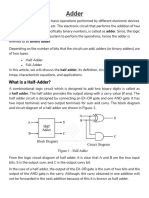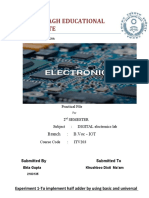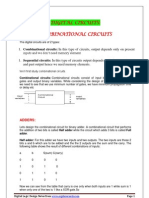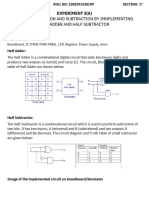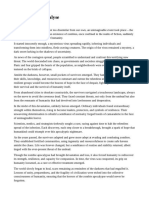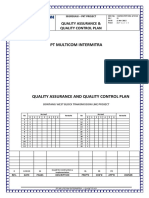Logic 6
Logic 6
Uploaded by
rio cassidyCopyright:
Available Formats
Logic 6
Logic 6
Uploaded by
rio cassidyOriginal Description:
Original Title
Copyright
Available Formats
Share this document
Did you find this document useful?
Is this content inappropriate?
Copyright:
Available Formats
Logic 6
Logic 6
Uploaded by
rio cassidyCopyright:
Available Formats
I.
Objectives
To be familiar and be able to create arithmetic and logic circuits To apply the function of logic circuit in arithmetic for combinational and sequential logic circuit
II.
Materials and Equipment Used
And gates Or gates Nand gates inverter LEDs Tact switches Breadboards Wires DC power supply
III.
Procedures
1. Research the following: definition, circuit diagram a) b) c) d) e) f) g) h) Half adder Half adder using nand gates Full adder Full adder using nand gates Half subtractor Half subtractor using nand gates Full subtractor Full subtractor using nand gates
2. Create their respective truth table and Karnaugh map to obtain their circuits. 3. Wire the circuit obtained.
IV.
Breadboard Layout
V.
Table and Results of Karnaugh Mapping
A B 0 0 0 1 1 0 1 1 Half Adder Sum 0 1 1 0 Carry 0 0 0 1 A B C 0 0 0 0 0 1 0 1 0 0 1 1 1 0 0 1 0 1 1 1 0 1 1 1 Full Adder Sum 0 1 1 0 1 0 0 1 Carry 0 0 0 1 0 1 1 1
A B 0 0 0 1 1 0 1 1
Half Subtractor Difference Borrow 0 0 1 1 1 0 0 0
A B C 0 0 0 0 0 1 0 1 0 0 1 1 1 0 0 1 0 1 1 1 0 1 1 1
Full Subtractor Difference 0 1 1 0 1 0 0 1
Borrow 0 1 1 1 0 0 0 1
SUM HALF ADDER FULL ADDER : : AB + AB ABC + ABC + ABC + ABC DIFFERENCE HALF SUBTRACTOR FULL SUBTRACTOR : : AB + AB ABC + ABC + ABC + ABC
CARRY AB AB + BC + AC BORROW AB AB + AC + BC
VI.
Data Analysis
The combinational circuits I constructed were the half and full adder and the half and full subtractor. Half adder is a combinational circuit that performs addition of two bits, as addends, while the full adder adds three bit, the two significant bits and a previous carry. On the other hand, half subtractor performs subtraction of two bits, the minuend and the subtrahend, while the full subtractor operates in three inputs, the minuend and subtrahend and a previous borrow. Their outputs are shown on the previous truth tables. Using those truth tables, their resulting circuits are obtained through Karnaugh mapping. Just like the previous experiments and knowing the principles of Karnaugh mapping, I came up with the minimized circuits.
HALF ADDER FULL ADDER HALF SUBTRACTOR FULL SUBTRACTOR
: : : :
SUM AB + AB ABC + ABC + ABC + ABC DIFFERENCE AB + AB ABC + ABC + ABC + ABC
CARRY AB AB + BC + AC BORROW AB AB + AC + BC
VII.
Results and Discussion
In this experiment, we first research about the combinational circuits we are to construct. After knowing how their perform, we created their truth tables and used it to obtain their circuits/equations for us to wire it. On one breadboard, we constructed them first using the XOR gates, OR gates, and AND gates while on another breadboard, we constructed them using NAND gates only. After constructing these combinational circuit, we tested it if we really made it right. And finally, after testing them, we have verified the truth tables through the data we obtained upon testing those circuits.
VIII.
Conclusion
After doing the experiment, I became familiar with the combinational circuits we used here such as the half adder, full adder, half subtractor, and the full subtractor. Aside from familiarizing myself to them, I was able to create and use them for arithmetic operation, addition and subtraction, of two-three bits.
IX.
Research
HALF ADDER & FULL ADDER THEORY: The most basic arithmetic operation is the addition of two binary digits. There are four possible elementary operations, namely, 0+0=0 0+1=1 1+0=1 1 + 1 = 102 The first three operations produce a sum of whose length is one digit, but when the last operation is performed the sum is two digits. The higher significant bit of this result is called a carry and lower significant bit is called the sum. HALF ADDER: A combinational circuit which performs the addition of two bits is called half adder. The input variables designate the augend and the addend bit, whereas the output variables produce the sum and carry bits. FULL ADDER: A combinational circuit which performs the arithmetic sum of three input bits is called full adder. The three input bits include two significant bits and a previous carry bit. A full adder circuit can be implemented with two half adders and one OR gate. HALF ADDER TRUTH TABLE: S.No 1. 2. 3. 4. INPUT A 0 0 1 1 OUTPUT S 0 1 1 0
B 0 1 0 1
C 0 0 0 1
CIRCUIT DIAGRAM:
FULL ADDER TRUTH TABLE: S.No 1. 2. 3. 4. 5. 6. 7. 8. INPUT A 0 0 0 0 1 1 1 1 OUTPUT SUM 0 1 1 0 1 0 0 1
B 0 0 1 1 0 0 1 1
C 0 1 0 1 0 1 0 1
CARRY 0 0 0 1 0 1 1 1
DESIGN: From the truth table the expression for sum and carry bits of the output can be obtained as, SUM = ABC + ABC + ABC + ABC CARRY = ABC + ABC + ABC +ABC Using Karnaugh maps the reduced expression for the output bits can be obtained as, SUM
SUM = ABC + ABC + ABC + ABC = A CARRY
CARRY = AB + AC + BC
CIRCUIT DIAGRAM:
HALF SUBTRACTOR & FULL SUBTRACTOR THEORY: The arithmetic operation, subtraction of two binary digits has four possible elementary operations, namely, 0-0=0 0 - 1 = 1 with 1 borrow 1-0=1 1-1=0 In all operations, each subtrahend bit is subtracted from the minuend bit. In case of the second operation the minuend bit is smaller than the subtrahend bit, hence 1 is borrowed. HALF SUBTRACTOR: A combinational circuit which performs the subtraction of two bits is called half subtractor. The input variables designate the minuend and the subtrahend bit, whereas the output variables produce the difference and borrow bits. FULL SUBTRACTOR: A combinational circuit which performs the subtraction of three input bits is called full subtractor. The three input bits include two significant bits and a previous borrow bit. A full subtractor circuit can be implemented with two half subtractors and one OR gate.
HALF SUBTRACTOR TRUTH TABLE: S.No 1. 2. 3. 4. INPUT A 0 0 1 1 OUTPUT DIFF 0 1 1 0
B 0 1 0 1
BORR 0 1 0 0
CIRCUIT DIAGRAM:
FULL SUBTRACTOR TRUTH TABLE:
INPUT S.No A 1. 2. 3. 4. 5. 6. 7. 8. 0 0 0 0 1 1 1 1 B 0 0 1 1 0 0 1 1 C 0 1 0 1 0 1 0 1
OUTPUT DIFF 0 1 1 0 1 0 0 1 BORR 0 1 1 1 0 0 0 1
DESIGN: From the truth table the expression for difference and borrow bits of the output can be obtained as, Difference, DIFF= ABC + ABC + ABC + ABC Borrow, BORR = ABC + ABC + ABC +ABC Using Karnaugh maps the reduced expression for the output bits can be obtained as, DIFFERENCE
DIFF = ABC + ABC + ABC + ABC = A BORROW
BORR = AB + AC + BC CIRCUIT DIAGRAM:
You might also like
- Half and Full Adder Circuit ReportDocument19 pagesHalf and Full Adder Circuit ReportNatasha Parti60% (10)
- DCS FA-18C Hornet GuideDocument626 pagesDCS FA-18C Hornet Guidemarco100% (2)
- DEC Report 4 (C)Document11 pagesDEC Report 4 (C)S M Akash100% (1)
- Binary Adder: A Full Adder CircuitDocument8 pagesBinary Adder: A Full Adder CircuitSejal KankriyaNo ratings yet
- Arithmetic Circuits AimDocument6 pagesArithmetic Circuits AimSandeep Kamti BrzeeNo ratings yet
- Combinational Circuits DesignDocument32 pagesCombinational Circuits DesignRudra ChauhanNo ratings yet
- Experiment Name: Adder and SubtractorDocument13 pagesExperiment Name: Adder and SubtractorA K M Fahim Faysal (182016018)No ratings yet
- Lab 5 - Combinational Logic-Adders and SubtractorsDocument11 pagesLab 5 - Combinational Logic-Adders and SubtractorsAngelicaNo ratings yet
- Dayalbagh Educational Institute: Experiment 1-To Implement Half Adder by Using Basic and UniversalDocument41 pagesDayalbagh Educational Institute: Experiment 1-To Implement Half Adder by Using Basic and UniversalKhushi GuptaNo ratings yet
- Unit 4 de (3e)Document43 pagesUnit 4 de (3e)Venu naidu KavaliNo ratings yet
- Basic GatesDocument7 pagesBasic GatesMAMTA KUMARINo ratings yet
- Unit5 Complete K2451Document82 pagesUnit5 Complete K2451ruthvikraj2005No ratings yet
- Chapter 3 Combinational CircuitsDocument22 pagesChapter 3 Combinational Circuitsabhijitshinde989sNo ratings yet
- Lecture 10-Half and Full AdderDocument9 pagesLecture 10-Half and Full Addersubratyadav01No ratings yet
- Unit 3Document34 pagesUnit 3Brooke DNo ratings yet
- EEE 304 - Exp3 PDFDocument5 pagesEEE 304 - Exp3 PDFAurongo NasirNo ratings yet
- Full SubtractorDocument6 pagesFull SubtractorPrerna Sharma100% (1)
- Linear Integrated Circuits Lab ManualDocument74 pagesLinear Integrated Circuits Lab Manualarivurp100% (2)
- CH - En.u4cse19105 de Lab 2Document21 pagesCH - En.u4cse19105 de Lab 2Uma Shankar CheduriNo ratings yet
- Full Adder Using Half AdderDocument4 pagesFull Adder Using Half AdderNiraj Shetty100% (1)
- Co Lab ManualDocument22 pagesCo Lab ManualSachin Saxena100% (2)
- Week Eight - Combinational CircuitsDocument10 pagesWeek Eight - Combinational Circuitsnjamaa91No ratings yet
- 6 - Combinational CurcuitDocument38 pages6 - Combinational CurcuitPlay StoreNo ratings yet
- DCC Expt 006Document5 pagesDCC Expt 006Vinay YadavNo ratings yet
- Adder CircuitDocument25 pagesAdder Circuitsenpaixd0110No ratings yet
- Coa Exp2Document3 pagesCoa Exp2anshkasaudhan71463No ratings yet
- EXP-1Document10 pagesEXP-1nileshmarathe166No ratings yet
- DE unit 3 (2)Document39 pagesDE unit 3 (2)ravi190917No ratings yet
- Lecture 1428911354Document22 pagesLecture 1428911354VervergNo ratings yet
- Digital Systems Lab ManualDocument63 pagesDigital Systems Lab Manualinfant199218No ratings yet
- STLD Unit IIIDocument29 pagesSTLD Unit IIIsnow54685No ratings yet
- Half/Full Adder AndHalf/Full SubtractorDocument6 pagesHalf/Full Adder AndHalf/Full SubtractorJames Kevin Ignacio100% (10)
- Design of Half Full Adder, Half Full Subtractor and Parallel AddersubtractorDocument7 pagesDesign of Half Full Adder, Half Full Subtractor and Parallel AddersubtractorMani Bharathi100% (2)
- Digital Lab CS2207 Lab ManualDocument41 pagesDigital Lab CS2207 Lab ManualSingh VelNo ratings yet
- Chapter 4 Lesson AddersDocument6 pagesChapter 4 Lesson AddersCAMANO YSRAELNo ratings yet
- Basic Digital Logic Design NotesDocument138 pagesBasic Digital Logic Design NotesSagar AgarwalNo ratings yet
- THESISDocument25 pagesTHESISSanayNo ratings yet
- Exper5 Digital Adders-SubtractorsDocument5 pagesExper5 Digital Adders-SubtractorsPECMURUGANNo ratings yet
- Lab 5 Adders SubtractorsDocument2 pagesLab 5 Adders SubtractorsTechnical InformationNo ratings yet
- De Lab Manual-EEE New1Document77 pagesDe Lab Manual-EEE New1selva_raj215414No ratings yet
- Unit 2 Combinational CircuitsDocument29 pagesUnit 2 Combinational Circuitsvidyadevi6996No ratings yet
- DLD Set 1Document10 pagesDLD Set 1mdrabbigazi2000No ratings yet
- UNIT-3-FCDDocument115 pagesUNIT-3-FCDAdbhutha BNo ratings yet
- DLD Set 1Document9 pagesDLD Set 1mdrabbigazi2000No ratings yet
- Cs2207 LMDocument66 pagesCs2207 LMShan MugamNo ratings yet
- Experiment 9Document3 pagesExperiment 9vkrNo ratings yet
- Digital LabDocument64 pagesDigital LabPurush JayaramanNo ratings yet
- Combinational CircuitsDocument13 pagesCombinational Circuitsonepiecezoro9883No ratings yet
- DSD Lab Manual AitdDocument31 pagesDSD Lab Manual Aitdprathameshbhat88No ratings yet
- DLD Lab Report-2Document2 pagesDLD Lab Report-2nwuoneandzeroNo ratings yet
- COEN 3103 Lesson 6 - 7 - Arithnetic and Logic Function CircuitsDocument68 pagesCOEN 3103 Lesson 6 - 7 - Arithnetic and Logic Function CircuitsAkosi LenaNo ratings yet
- Bsc i Year Comp.arch FileDocument26 pagesBsc i Year Comp.arch Fileshruti gargNo ratings yet
- VAIBHAV Coa Exp2 PDFDocument5 pagesVAIBHAV Coa Exp2 PDFvc6094055No ratings yet
- 2-Bit Full Adder Circuit (EEE-1024/DA (Theory) ) : Adithya Hariprakash 21MIC0031Document11 pages2-Bit Full Adder Circuit (EEE-1024/DA (Theory) ) : Adithya Hariprakash 21MIC0031Adithya HariprakashNo ratings yet
- Introduction To Digital System Laboratory PDFDocument32 pagesIntroduction To Digital System Laboratory PDFAdhitya Rahman100% (1)
- Lecture 02Document32 pagesLecture 02Sadi RifatNo ratings yet
- Adder-Subtracter: Digital Circuits Adding Subtracting BinaryDocument8 pagesAdder-Subtracter: Digital Circuits Adding Subtracting BinaryPathan SaifNo ratings yet
- Module 2-DDCODocument33 pagesModule 2-DDCOshreyadevraj874No ratings yet
- Fundamentals of Electronics 2: Continuous-time Signals and SystemsFrom EverandFundamentals of Electronics 2: Continuous-time Signals and SystemsNo ratings yet
- Design of Electrical Circuits using Engineering Software ToolsFrom EverandDesign of Electrical Circuits using Engineering Software ToolsNo ratings yet
- Temperature Measurement PDFDocument213 pagesTemperature Measurement PDFRicky CaballeroNo ratings yet
- Engineering Bulletin - EB04-004: Stamping Error, 1.5" SPM Valve Outer Spring (35-504018) ScopeDocument2 pagesEngineering Bulletin - EB04-004: Stamping Error, 1.5" SPM Valve Outer Spring (35-504018) ScopeJean DuboisNo ratings yet
- Title Ix Synthesis EssayDocument5 pagesTitle Ix Synthesis Essaygbv7kahm100% (2)
- (PTE Helper) Advanced Plus 2 Reading & Listening - Student BookDocument205 pages(PTE Helper) Advanced Plus 2 Reading & Listening - Student BookHUYNH DUYNo ratings yet
- Week 12 SB - Si Lando (Si Lando)Document20 pagesWeek 12 SB - Si Lando (Si Lando)Jacquelyn Buscano Dumayhag100% (3)
- MotherboardDocument9 pagesMotherboardshree_0073No ratings yet
- SubstationDocument33 pagesSubstationjogiyajee100% (1)
- ESSENTIALS OF COGNITIVE PSYCHOLOGY 1704806919. - PrintDocument159 pagesESSENTIALS OF COGNITIVE PSYCHOLOGY 1704806919. - PrintphanvuhaiquyNo ratings yet
- NCERT Solutions For Class 10 Chapter 2 PolynomialsDocument16 pagesNCERT Solutions For Class 10 Chapter 2 PolynomialsAbhijith MohanNo ratings yet
- Specific Terms and Conditions For Ambank Bonuslink Visa CardDocument16 pagesSpecific Terms and Conditions For Ambank Bonuslink Visa Cardsmsd onlineNo ratings yet
- Shelters From 1,120 To 1,535 FT (104 To 142.6 M) of Usable SpaceDocument2 pagesShelters From 1,120 To 1,535 FT (104 To 142.6 M) of Usable SpacebstockusNo ratings yet
- TK 51530 C-Series Rev 3 04-06 enDocument6 pagesTK 51530 C-Series Rev 3 04-06 enVasile SilvioNo ratings yet
- The Psychoanalytic Quarterly - 2013 - FLIESS - THE METAPSYCHOLOGY OF THE ANALYSTDocument17 pagesThe Psychoanalytic Quarterly - 2013 - FLIESS - THE METAPSYCHOLOGY OF THE ANALYSTcecilia.stanisciaNo ratings yet
- SBKJ - Spiral Tubeformer 1602 Decoiler DVC1000Document18 pagesSBKJ - Spiral Tubeformer 1602 Decoiler DVC1000rinconvega0% (1)
- X Series MIDI Keyboard-Owner's Manua - 20150603Document12 pagesX Series MIDI Keyboard-Owner's Manua - 20150603TiagoMartinsNo ratings yet
- Solo Leveling Chapter 163 Bahasa IndonesiaDocument7 pagesSolo Leveling Chapter 163 Bahasa Indonesiavjb8h55dzjNo ratings yet
- The Zombie ApocalypseDocument2 pagesThe Zombie ApocalypseEthelwolf UltimateNo ratings yet
- Quality Assurance PlanDocument24 pagesQuality Assurance PlanRudi Erianto100% (3)
- 1 - Sitting Movement Analysis WorksheetDocument2 pages1 - Sitting Movement Analysis WorksheetSM199021No ratings yet
- Diamon, Jared - Why Societies Collapse (Talk at Princeton Uni) - Princeton Univ Press (2003)Document16 pagesDiamon, Jared - Why Societies Collapse (Talk at Princeton Uni) - Princeton Univ Press (2003)Jared HernandezNo ratings yet
- Rev. Méd. Chile - PDF Download - ArtDocument9 pagesRev. Méd. Chile - PDF Download - Artrodrigo naviaNo ratings yet
- Games Design Fundamentals SlidesDocument44 pagesGames Design Fundamentals SlidesjaulloqueNo ratings yet
- MA3004 Part 3: Computational Fluid Dynamics (CFD) : Martin SkoteDocument46 pagesMA3004 Part 3: Computational Fluid Dynamics (CFD) : Martin SkotedavidbehNo ratings yet
- Senior Resume 2019Document2 pagesSenior Resume 2019api-459898875No ratings yet
- Powerfactory 15.1 Release Notes: Digsilent Technical DocumentationDocument17 pagesPowerfactory 15.1 Release Notes: Digsilent Technical DocumentationaasdfNo ratings yet
- Fee Structure Fall 2024Document1 pageFee Structure Fall 2024matiullah.matviNo ratings yet
- Q1M1 Electronic Symbols PDFDocument28 pagesQ1M1 Electronic Symbols PDFpjsfrance100% (1)
- Class 11 - Cs Lab Manual 2024-2025Document16 pagesClass 11 - Cs Lab Manual 2024-2025vinuNo ratings yet
- FinalDocument3 pagesFinalTMedhin MisganawNo ratings yet





